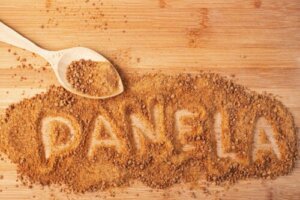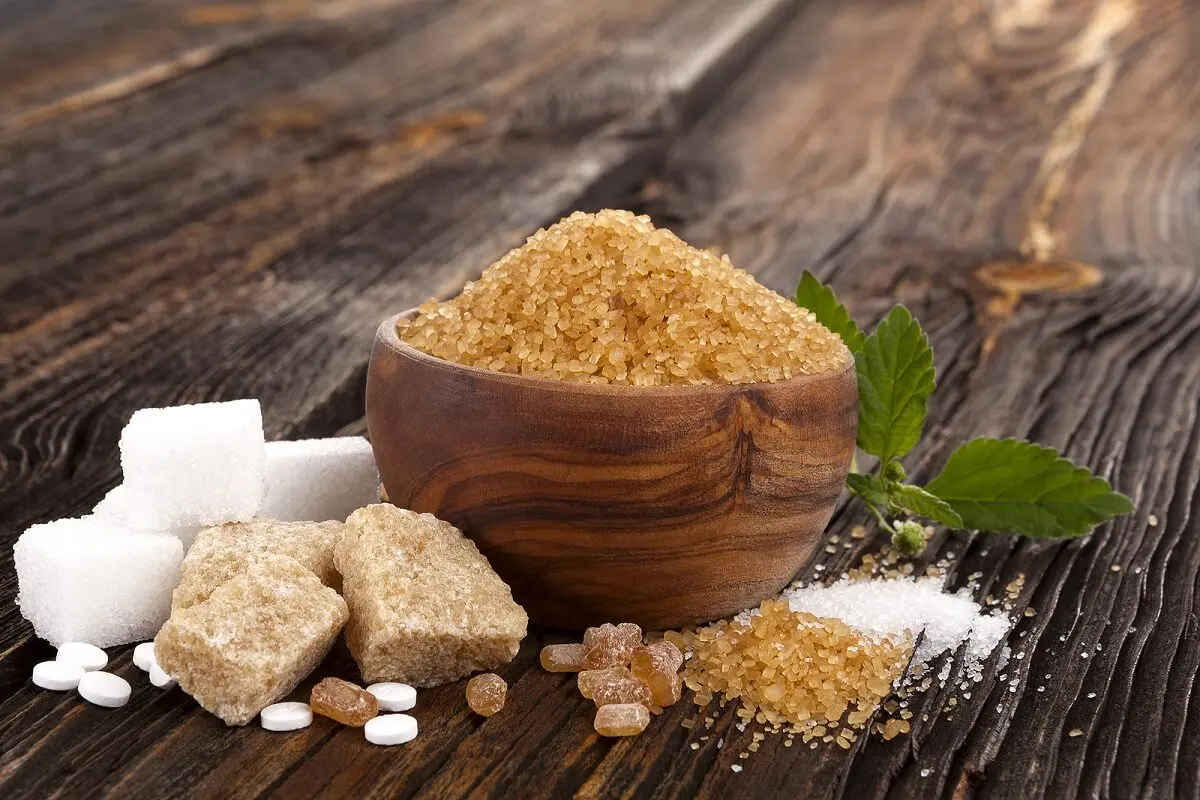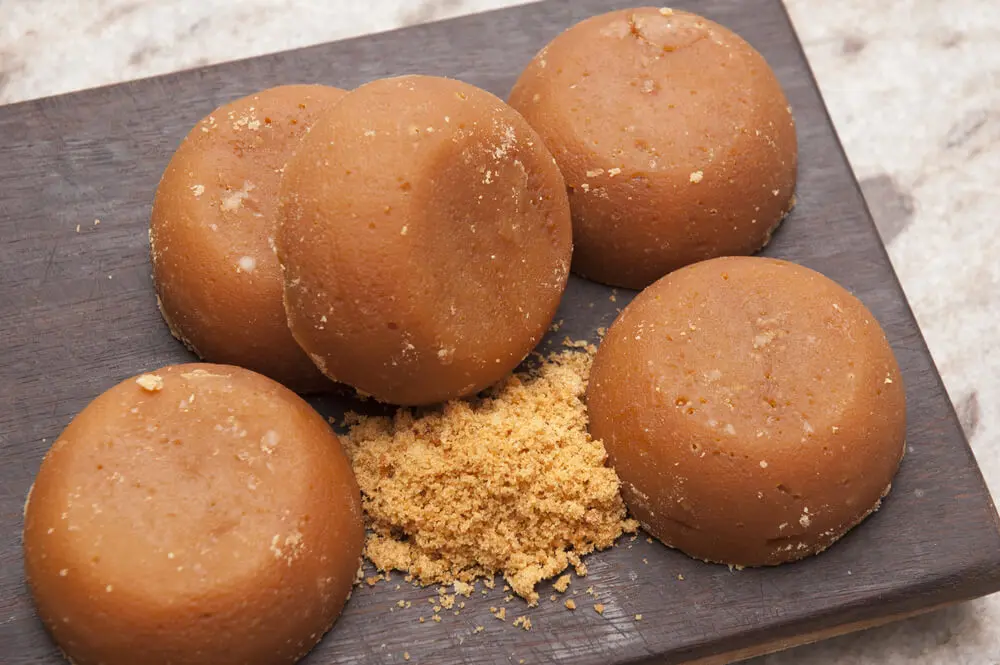Panela: Benefits and Contraindications


Written and verified by the nutritionist Maria Patricia Pinero Corredor
Nowadays, when governmental organizations promote a healthy lifestyle, natural substitutes for refined sugar are sought to sweeten certain recipes. Panela is one of them, as it has fewer calories. In addition, it’s also a surprisingly useful ingredient in the gastronomic world.
Panela owes its name to the rectangular blocks used to mold the molasses obtained from sugar cane juice. Its origin dates back to the conquest of the American continent by the Spaniards, and it was also popular in India. It’s said that its nutritional value surpasses that of refined sugar.
A bit of history
Nutritionist Maria Mascieti has explained all about the history of panela. This product is obtained from sugar cane, a plant native to New Guinea which, in 1538, during the Spanish conquest, was planted and spread in Colombia. Since that time, the peasants built the so-called trapiches (a mill made from wooden rollers) to grind and squeeze the cane, obtaining a sweet drink.
According to the Association of Farmers and Sugar Cane Producers, these crops are among the oldest in the world. They’re thought to have begun some 3000 years before the modern era, in New Guinea.
Since 1650, sugar cane juice was obtained by hand, using hundreds of African slaves as labor. Over the years and with technological advances, human and animal power was replaced by hydraulic systems and engines that made the process faster.
By the 17th century, sugar cane cultivation spread to various areas of Colombia, obtaining derivative products such as guarapo, white sugar, brown sugar, and panela.
According to a document from the Colombian Ministry of Agriculture, 25 countries produce panela. Some 61% of the total sugar cane cultivated is used to obtain the product.

Another interesting article: Learn How Sugar Can Affect the Heart
Preparation of panela
Pierre Raymond, in the article “Hacienda tradicional y aparcería” (Traditional farm and sharecropping”) – which is, unfortunately, all in Spanish – explains the process of obtaining panela. The sugar cane is pressed, as we mentioned before, in a mill called a trapiche, with the output of a natural sweet cane juice. This juice is concentrated, placing the pot on the fire until it thickens like honey, which contains 78 kilos of sugar for every 100 kilos of honey.
Then it continues to evaporate until it reaches 93 kilos of sugar. It’s added to some molds or gaveras, where it becomes compact and solid. This is now the panel block, which is 96 kilos of sugar for every 100 kilos of honey. It continues to be beaten intensely until granulated panela is obtained.
According to a group of agro-industrial engineers, the correct measurement of the amount of sugar in the honey is crucial in order to obtain good quality panela. Attention must also be paid to raw materials, tools, and personnel.
Panela is also called brown sugar, raspadura, papelón, piloncillo, empanizado, chancaca or panocha in Latin American countries. In India and Pakistan, it’s called gur or jaggery.
As panela isn’t refined or centrifuged, nor goes through any other form of purification, it retains all the properties of sugar cane.
Nutritional characteristics of panela
According to the technical data sheet published for panela, it must comply with the following nutritional components in grams per 100 grams (4 oz) of panela:
- Humidity: 2.3.
- Reduced sugars: 3,74.
- Fat: 0,29.
- Sucrose: 93,37.
- Proteins: 0,62.
- Ashes: 1,61.
- Total calories: 383,97 kilocalories.
Minerals are expressed in milligrams per kilogram of panela:
- Sodium: 241,6.
- Iron: 24,94.
- Zinc: 12,74.
- Calcium: 356,84.
- Potassium: 593,73.
- Magnesium: 386,32.
As we can see, because panela is a natural product, it retains the nutritional properties of sugar cane. The only difference is that, in common sugar, the sucrose is almost 100%. In addition, panela has the minerals of its raw material.
Discover more here: Is Brown Sugar Better than White Sugar?
Properties of panela
Despite being a sweetener with high amounts of sugar, panela has a number of properties that we’ll discuss below:
- It’s a handmade product – not processed – and it doesn’t contain any additives. This gives it certain advantages over refined sugar, which only provides empty calories. Although 100 grams (4 oz) of panela also contain a high energy value.
- It’s a natural sweetener that contains certain nutrients that aren’t present in refined sugar. For example, it provides iron, potassium, magnesium, and calcium. But we must take into account that these values are expressed in milligrams per kilogram of panela consumed. It’s impossible and counterproductive to eat so much panela to obtain these micronutrients.
- Wellington Villalta, from the University of Cuenca, states in his essay that panela provides quick energy, moisturizes the skin, and acts as a healing agent. Like traditional honey, panela honey also has a balsamic and expectorant effect.
- According to the Technical University of Ecuador, panela with hot water relieves colds.
Let’s remember that high sugar consumption is associated with the development of chronic diseases, such as cardiovascular diseases, type 2 diabetes and metabolic pathologies. In addition to this, more scientific studies are needed to support this information.

The use of panela in gastronomy
The sweetening capacity of panela is similar to that of white sugar. For this reason, it’s used as a substitute in the preparation of sweets, jams, syrups, cakes, and other baking recipes.
Panela is often used to prepare hot or cold sweetened drinks. One example is the famous and refreshing lemon juice with panela. It’s popular in Latin American countries, especially in Venezuela.
Other simple drinks that are easy to prepare at home are bitter chocolate or coffee with panela, traditional in Colombia, and aguapanela, typical of the Caribbean. It’s drunk cold and gives you energy.
Manjar de harina de maíz con coco – a corn coconut recipe – is a dessert. Other Latin American sweets are melcochas and alfandoque (a type of cheesecake) You can prepare the famous guarapo, which is an alcoholic drink obtained by the fermentation of this product.
Panela is a versatile sweetener, since it isn’t only used to make pastry and confectionery products, but can also be a secret ingredient in some recipes that require a contrasting touch of sweetness. At Christmas, it’s used in many South American countries to caramelize and contrast the baked pork leg.
Contraindications of panela
Although panela is a natural sweetener, it still has a high concentration of sugar. Here are the most striking contraindications that should be taken into account:
- It can produce a greater sensation of hunger: a group of pharmacologists and biochemists from Mexico assures that leptin, a peptide that regulates the sensation of hunger, is altered when sugar is consumed. In obese people, leptin resistance has been found, which leads to increased appetite.
- It isn’t suitable for diabetics: Although it’s true that it has less sugar than refined sugar, the predominant carbohydrate is sucrose.
- Harmful to dental health: the sugar contained in panela, if consumed frequently, can affect the enamel and facilitate the appearance of cavities.
- Causes weight gain: If you eat it in excess, it will be very easy to accumulate fat and gain weight.
Panela should be consumed responsibly. More controlled research is needed on what generates its intake in some chronic diseases in humans. So far, its main proven effects are energetic, healing, and moisturizing for the skin.
All cited sources were thoroughly reviewed by our team to ensure their quality, reliability, currency, and validity. The bibliography of this article was considered reliable and of academic or scientific accuracy.
- Castro, R. M. (14 de enero de 2023). Artificial sweeteners: any effect on blood sugar? Clínica Mayo. https://www.mayoclinic.org/diseases-conditions/diabetes/expert-answers/artificial-sweeteners/faq-20058038
- DiNicolantonio, J., & O’Keefe, J. H. (2022). Added sugars drive insulin resistance, hyperinsulinemia, hypertension, type2 diabetes and coronary heart disease. Missouri Medicine. 119(6): 519-523. https://www.ncbi.nlm.nih.gov/pmc/articles/PMC9762218/
- Gonzalez Cortés, C. (2009). Estudio del proceso de producción de panela en la finca Berlín. Facultad de Ciencias Empresariales de la Corporación Universitaria Minutos de Dios. Santa Fe de Bogotá D.C. https://repository.uniminuto.edu/bitstream/10656/628/1/TCA_GonzalezCristian_2009.pdf
- Harvard T. H. Cha. Harvard School of Public Health. (Abril de 2022). Added sugar. Consultado el 13 de junio de 2024. https://nutritionsource.hsph.harvard.edu/carbohydrates/added-sugar-in-the-diet/
- Mascietti, M. M. (2014). Panela: propiedades, información y aceptación. REDI─Universidad Fasta. http://redi.ufasta.edu.ar:8082/jspui/handle/123456789/771
- Ndumele, C. E. (s.f.). Obesity, sugar and heart health. Johns Hopkins Medicine. Consultado el 13 de junio de 2024. https://www.hopkinsmedicine.org/health/wellness-and-prevention/obesity-sugar-and-heart-health
- Organización Mundial de la Salud (OMS). (2015). Directriz: ingesta de azúcares para niños y adultos. Resumen. https://iris.who.int/bitstream/handle/10665/154587/WHO_NMH_NHD_15.2_spa.pdf?sequence=2&isAllowed=y
- World Health Organization (WHO). (15 de mayo de 2023). WHO advises not to use non-sugar sweeteners for weight control in newly released guideline. https://www.who.int/news/item/15-05-2023-who-advises-not-to-use-non-sugar-sweeteners-for-weight-control-in-newly-released-guideline
This text is provided for informational purposes only and does not replace consultation with a professional. If in doubt, consult your specialist.








